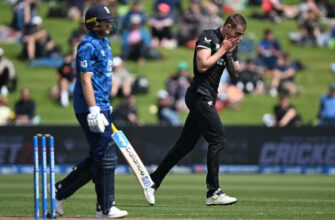The Asia Cup 2025 final was more than just a cricket match; it was a pulsating narrative woven with threads of pressure, resilience, and the raw, unfiltered emotion that defines sport. In a contest that pitted long-standing rivals India and Pakistan against each other, a young batsman delivered a moment of pure brilliance, prompting an uncharacteristically fervent reaction from a coaching legend. This is the story of Tilak Varma’s defining six, Gautam Gambhir’s desk, and India’s hard-fought triumph under the glittering Dubai night sky.
The Cauldron of Rivalry: India vs. Pakistan
Cricket between India and Pakistan isn`t merely a game; it`s an event steeped in history, tension, and fervent national pride. The Asia Cup 2025 final in Dubai represented the pinnacle of this rivalry, with both teams having already clashed twice in the tournament, India emerging victorious on both occasions. The atmosphere was thick with anticipation, and perhaps a touch of underlying geopolitical chill, given the conspicuous absence of the traditional handshake during previous encounters and even at the coin toss. This wasn`t just about runs and wickets; it was about bragging rights, national honor, and for some, perhaps even a subtle reassertion of dominance.
A Chase Fraught with Peril
Pakistan, batting first, had set a target of 147 runs after collapsing from a promising 113-1 to 146 all out in 19.1 overs. It wasn`t an insurmountable total, but against a high-quality attack and in the pressure cooker of a final, it felt daunting. India’s chase began disastrously. The scoreboard quickly painted a grim picture: 20 runs for 3 wickets down after just four overs, including the crucial dismissal of Abhishek Sharma for a mere 5 runs. The defending champions looked vulnerable, and the hopes of millions seemed to hang by a rapidly fraying thread. The question wasn’t if India would win, but if they could even mount a respectable recovery.
Tilak Varma: The Architect of Revival
Enter Tilak Varma. Still relatively new to the international stage, the young southpaw stepped into the breach with the composure of a seasoned veteran. Alongside the experienced Sanju Samson (24 runs), Varma began the arduous task of rebuilding. Their 57-run partnership provided a much-needed foundation, stemming the tide of wickets and slowly shifting the momentum. Yet, the real game-changing stand came with Shivam Dube, whose aggressive 33 off 22 balls injected urgency and belief into the chase. While Dube provided the fireworks, Varma played the anchoring role, meticulously accumulating runs and keeping the required rate in check. By the time the final over approached, he was batting on 60, carrying the weight of expectation with a calm demeanor that belied his age.
The Final Over: Haris Rauf vs. Tilak Varma
With just one over remaining, India needed 10 runs to clinch the title. The ball was in the hands of Pakistan`s express pace bowler, Haris Rauf. The tension was palpable; every eye in the stadium and across the cricketing world was fixed on the pitch. Rinku Singh, making his tournament debut, stood at the non-striker`s end, a silent observer to the unfolding drama. Varma, with his unbeaten 60, took a double off the first ball, chipping away at the target. Eight runs needed from five balls. Manageable, but far from guaranteed.
The Defining Blow and the Coach`s Roar
Then came the moment that would define the final. Rauf delivered the second ball of the over. Tilak Varma, with a blend of power and precision, swung his bat, connecting cleanly. The ball soared, majestic and true, over mid-wicket, disappearing into the Dubai night sky. Six runs! The equation instantly transformed: two runs needed from four balls. The collective gasp of the crowd was quickly replaced by a roar of jubilation. This was more than just a six; it was a pressure valve releasing, a declaration of intent, and a virtual seal on India`s victory.
And then, the cameras caught him. Gautam Gambhir, India`s head coach, a man known more for his tactical acumen and rarely seen without a serious, almost unyielding expression, was caught in a moment of pure, unadulterated emotion. He banged the desk, a powerful, almost primal gesture of relief and triumph. It was a sight as striking as Varma`s six, confirming the sheer magnitude of the moment and the immense pressure everyone involved had been under. Even the most stoic figures, it seems, have their breaking point—or, rather, their exhilaration point—when the stakes are this high.
Sealing the Deal: Rinku Singh`s Flourish
With the bulk of the hard work done by Varma, Rinku Singh then stepped up to finish the job. A boundary off mid-on, and India had done it. Five wickets in hand, two balls to spare. The celebrations erupted, a testament to a hard-fought battle won against their fiercest rivals. Tilak Varma, the star of the chase, remained unbeaten on 69 off 53 balls, a performance that cemented his place in the annals of Asia Cup folklore.
A Legacy Cemented, A Future Announced
India’s victory marked their second T20 Asia Cup triumph and ninth overall since the tournament’s inception in 1984. But beyond the statistics, this final will be remembered for its pulsating drama, the resilience of a team under pressure, and the emergence of a young talent capable of delivering when it matters most. Tilak Varma, with his unflappable demeanor and match-winning knock, announced his arrival as a potential future star. And Gautam Gambhir’s rare display of emotion served as a poignant reminder that even the most stoic professionals are not immune to the electrifying highs and lows of this magnificent sport.
The Asia Cup 2025 final offered everything cricket enthusiasts crave: fierce competition, nail-biting finishes, and moments of individual brilliance that transcend the game itself. It was a narrative woven with threads of despair, hope, and ultimate triumph, forever etched into the memories of those who witnessed it, a true spectacle of cricketing drama.







